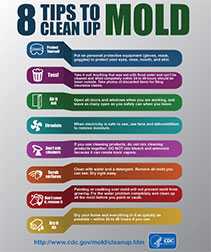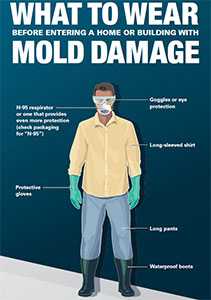Mold After a Disaster

Highlights
- People with asthma, allergies, or other breathing conditions may be more sensitive to mold.
- If you or your family members have health problems after exposure to mold, contact your doctor or other health care provider.
- Controlling moisture in your home is the most critical factor for preventing mold growth.
- If you plan to be inside the building for a while or you plan to clean up mold, you should buy N95 masks (or a respirator with a higher protection level) at your local home supply store and wear one while in the building. Make certain that you follow instructions on the package for fitting the mask tightly to your face. Even if you go back into the building for a short time and are not cleaning up mold, you need to wear an N95 mask.
After natural disasters such as hurricanes, tornadoes, and floods, excess moisture and standing water contribute to the growth of mold in homes and other buildings. When returning to a home that has been flooded, be aware that mold may be present and may be a health risk for your family.
People at Greatest Risk from Mold
- People with asthma, allergies, or other breathing conditions may be more sensitive to mold.
- People with immune suppression (such as people with HIV infection, cancer patients taking chemotherapy, and people who have received an organ transplant) are more susceptible to mold infections. People with a weakened immune system, especially people receiving treatment for cancer, people who have had an organ or stem cell transplant, and people taking medicines that suppress the immune system, should avoid cleaning up mold. Children under 12 should not enter a building with mold damage.
Possible Health Effects of Mold Exposure
People who are sensitive to mold may experience stuffy nose, irritated eyes, wheezing, or skin irritation. People allergic to mold may have difficulty in breathing and shortness of breath. People with weakened immune systems and with chronic lung diseases, such as obstructive lung disease, may develop mold infections in their lungs. If you or your family members have health problems after exposure to mold, contact your doctor or other health care provider.
Safely Preventing Mold Growth
Clean up and dry out the building quickly (within 24 to 48 hours). Open doors and windows. Use fans to dry out the building. Position fans to blow air out doors or windows.
See the fact sheet for drying out your house, Reentering Your Flooded Home and the Homeowner’s and Renter’s Guide to Mold Cleanup After Disasters.
- When in doubt, take it out! Remove all porous items that have been wet for more than 48 hours and that cannot be thoroughly cleaned and dried. These items can remain a source of mold growth and should be removed from the home. Porous, noncleanable items include carpeting and carpet padding, upholstery, wallpaper, drywall, floor and ceiling tiles, insulation material, some clothing, leather, paper, wood, and food. Removal and cleaning are important because even dead mold may cause allergic reactions in some people.
- To prevent mold growth, clean wet items and surfaces with detergent and water.
- Homeowners may want to temporarily store items outside of the home until insurance claims can be filed. See recommendations by the Federal Emergency Management Agency (FEMA).
- If you wish to disinfect, refer to the U.S. Environmental Protection Agency (EPA) document, A Brief Guide to Mold and Moisture in Your Home [1.4 MB, 20 Pages].
If there is mold growth in your home, you should clean up the mold and fix any water problem, such as leaks in roofs, walls, or plumbing. Controlling moisture in your home is the most critical factor for preventing mold growth.
To remove mold growth from hard surfaces use commercial products, soap and water, or a bleach solution of no more than 1 cup of household laundry bleach in 1 gallon of water. Follow the manufacturers’ instructions for use (see product label). Use a stiff brush on rough surface materials such as concrete.
If you choose to use bleach to remove mold:
- Never mix bleach with ammonia or other household cleaners. Mixing bleach with ammonia or other cleaning products will produce dangerous, toxic fumes
- Open windows and doors to provide fresh air. Use fans to dry out the building. Position fans to blow air out doors or windows.
- Wear non-porous gloves and protective eye wear.
- If the area to be cleaned is more than 10 square feet, consult the U.S. Environmental Protection Agency (EPA) guide titled Mold Remediation in Schools and Commercial Buildings. Also available is A Brief Guide to Mold, Moisture, and Your Home. [1.4 MB, 20 Pages]
- Always follow the manufacturer’s instructions when using bleach or any other cleaning product.
- For more information on personal safety while cleaning up after a natural disaster, see Response Worker Health and Safety.
If you plan to be inside the building for a while or you plan to clean up mold, you should buy N95 masks (or respirators with a higher protection level) at your local home supply store and wear one while in the building. Make certain that you follow instructions on the package for fitting the mask tightly to your face. Even if you go back into the building for a short time and are not cleaning up mold, you still need to wear an N95 mask.”
Other Mold Resources
- Clean Up Safely After a Disaster
- Reentering Your Flooded Home
- Mold – General Resources
- NIOSH Interim Recommendations for the Cleaning and Remediation of Flood-Contaminated HVAC Systems: A Guide for Building Owners and Managers
- Population-Specific Recommendations for Protection From Exposure to Mold in Flooded Buildings [487 KB, 2 Pages]
-
A Brief Guide to Mold, Moisture, and Your Home [1.4 MB, 20 Pages]
Resource from the U.S. Environmental Protection Agency (EPA) that includes Mold Cleanup Guidelines
Public Service Announcements
- Page last reviewed: October 11, 2017
- Page last updated: October 11, 2017
- Content source:


 ShareCompartir
ShareCompartir



